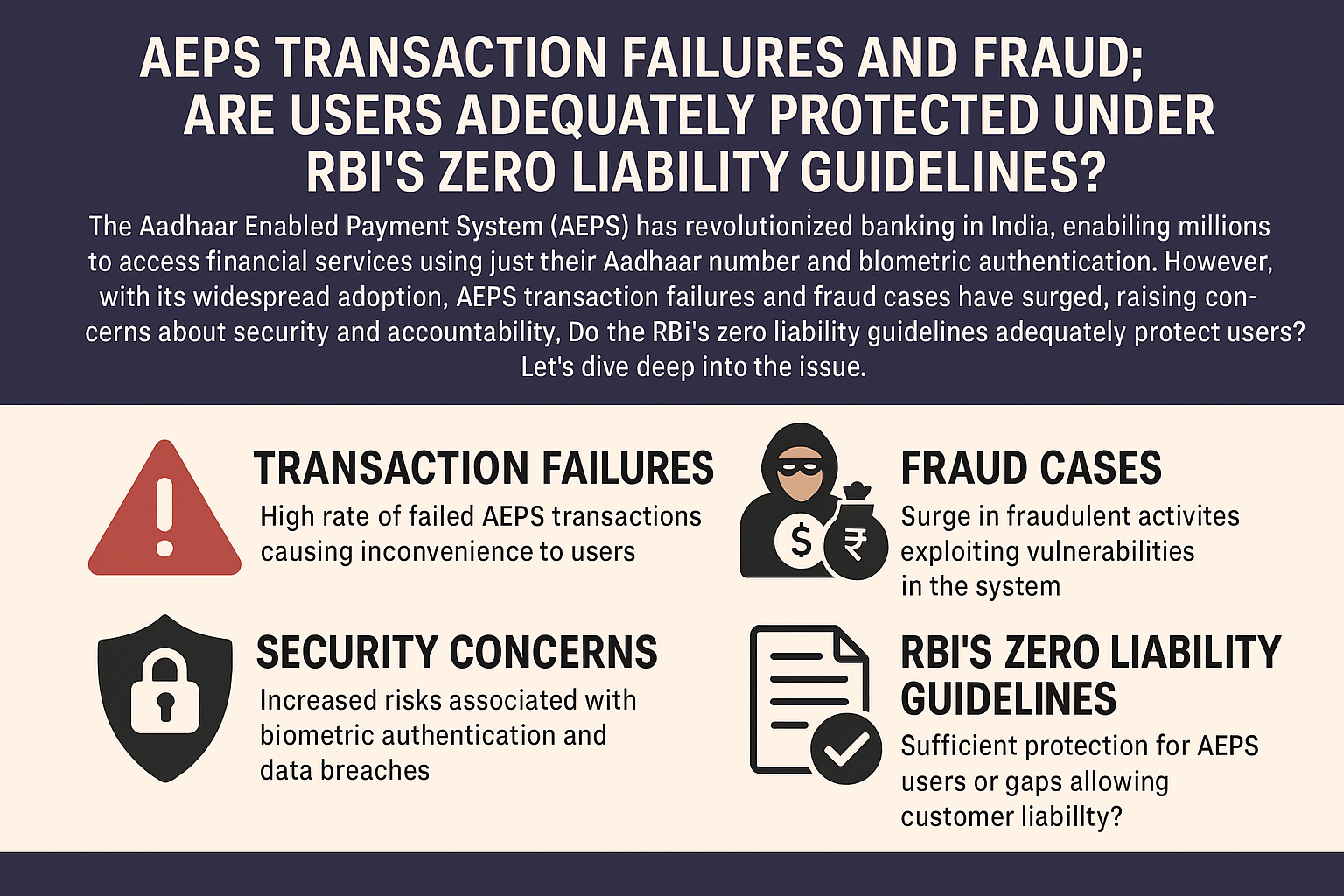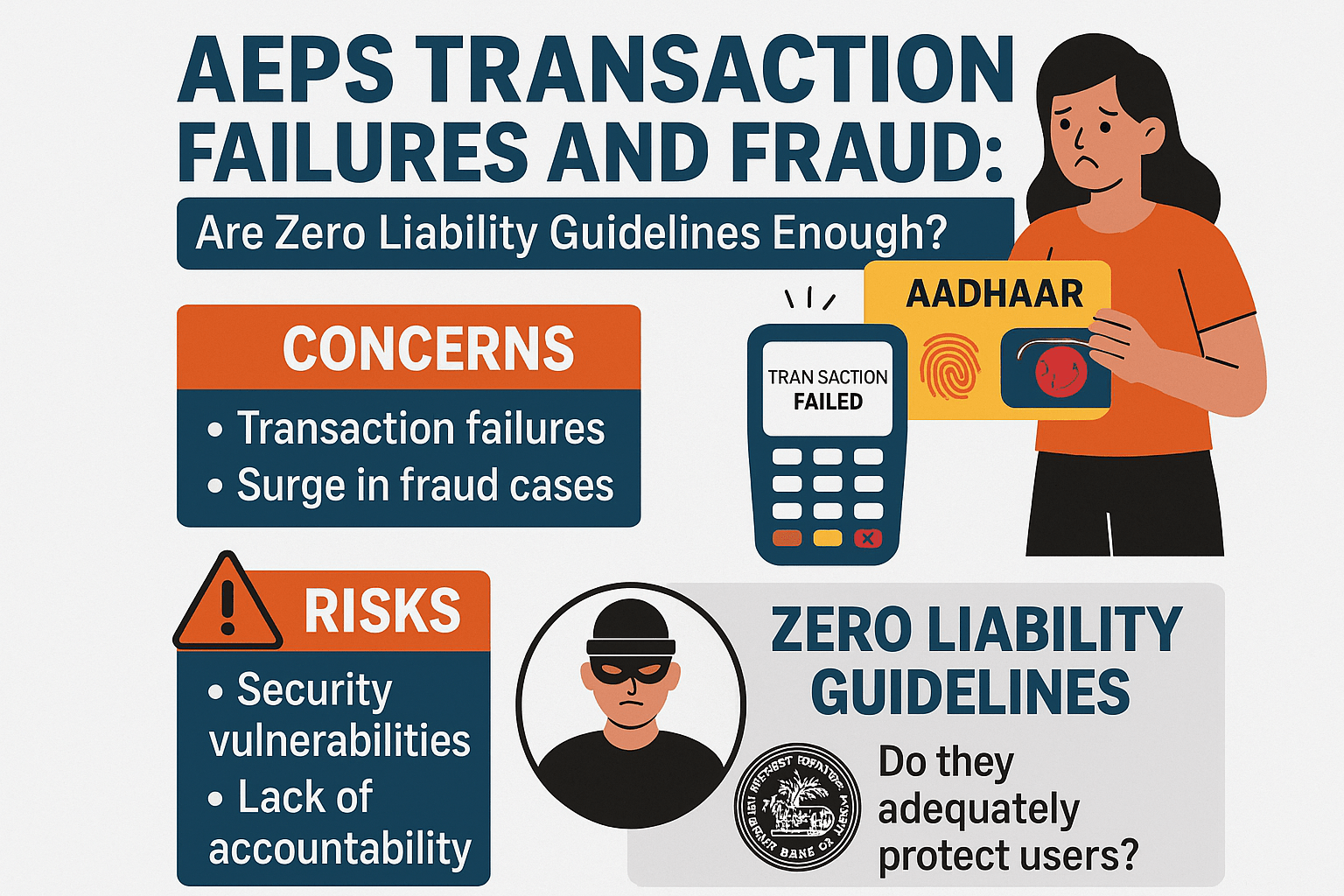The Aadhaar Enabled Payment System (AEPS) has revolutionized banking (AEPS transaction failures) in India, enabling millions to access financial services using just their Aadhaar number and biometric authentication. However, with its widespread adoption, AEPS transaction failures and fraud cases have surged, raising concerns about security and accountability. Do the RBI’s zero liability guidelines adequately protect users? Let’s dive deep into the issue.

Understanding AEPS Transaction Failures & Fraud
What is AEPS?
AEPS is a bank-led model allowing customers to perform basic banking transactions—cash withdrawals, deposits, balance checks, and fund transfers—using Aadhaar authentication. It’s particularly crucial in rural areas where traditional banking infrastructure is limited.
Common Causes of AEPS Transaction Failures
-
Biometric Authentication Failures – Fingerprint mismatches due to poor connectivity, worn-out fingerprints, or device errors.
-
Server Downtime – Technical glitches in banking servers or NPCI (National Payments Corporation of India) systems.
-
Insufficient Balance – Transactions fail if the account lacks sufficient funds.
-
Aadhaar-Bank Account Linking Issues – If Aadhaar isn’t correctly linked, transactions get rejected.
Rising Cases of AEPS Fraud
Fraudsters exploit vulnerabilities in the system through:
-
Biometric Spoofing – Using silicone fingerprints or cloned biometric data.
-
Man-in-the-Middle Attacks – Intercepting OTPs or session details.
-
Fake Banking Correspondents (BCs) – Unauthorized agents duping users into sharing Aadhaar details.
A 2022 report by the Reserve Bank of India (RBI) highlighted a 30% increase in AEPS-related frauds compared to the previous year, emphasizing the need for stricter safeguards.
RBI’s Zero Liability Policy: Does It Protect Users?
What is Zero Liability?
The RBI’s zero liability framework ensures that customers are not held responsible for unauthorized transactions if:
-
The fraud occurs due to a bank’s negligence (e.g., security breach).
-
The customer reports the fraud within 3 days.
-
There is no customer involvement in the fraud.
Does It Cover AEPS Frauds?
In theory, yes. However, in practice, victims often face hurdles:
-
Delayed Reporting – Rural users may not immediately notice fraudulent transactions.
-
Burden of Proof – Banks sometimes demand evidence, making resolution difficult.
-
Agent Misconduct – If fraud occurs via a Banking Correspondent, liability disputes arise.
Case Study: The AEPS Scam in Uttar Pradesh (2023)
In a notable incident, over 500 villagers in UP lost money due to unauthorized AEPS withdrawals. The bank initially denied claims, citing “customer negligence.” Only after RBI intervention were refunds processed—highlighting gaps in zero liability enforcement.

Challenges in Implementing RBI’s Guidelines
-
Lack of Awareness – Many users, especially in rural areas, are unaware of zero liability protections.
-
Slow Grievance Redressal – Banks often delay investigations, forcing customers to approach ombudsman.
-
Technical Loopholes – Fraudsters continuously evolve tactics, outpacing security measures.
How Can Users Protect Themselves?
✅ Monitor Transactions Regularly – Check bank statements/SMS alerts.
✅ Use Only Trusted BCs – Verify Banking Correspondent credentials.
✅ Report Immediately – Notify the bank within 3 days for zero liability coverage.
✅ Enable Transaction Limits – Restrict withdrawal amounts via AEPS.
Conclusion: Is RBI’s Zero Liability Effective?
While the RBI’s zero liability policy is a strong framework, its execution remains inconsistent. Banks must improve fraud detection, customer education, and dispute resolution to make AEPS truly secure. For now, users must stay vigilant to avoid falling victim to AEPS transaction failures and fraud.
Frequently Asked Questions (FAQs)
Q1. What should I do if my AEPS transaction fails but money is deducted?
-
Immediately contact your bank with transaction details. If unresolved, escalate to the RBI Banking Ombudsman.
Q2. Can someone withdraw money using just my Aadhaar number?
-
No, biometric authentication is required. However, if fingerprints are cloned, fraud can occur.
Q3. How long do banks take to refund money in AEPS fraud cases?
-
Under RBI rules, banks must resolve complaints within 90 days, but delays are common.
Q4. Are all AEPS frauds covered under zero liability?
-
Only if reported within 3 days and without customer negligence.
Disclaimer
This article is for educational purposes only. If you have any concerns regarding this content, please visit our DMCA page for post removal requests. Always verify banking policies with official RBI guidelines.
